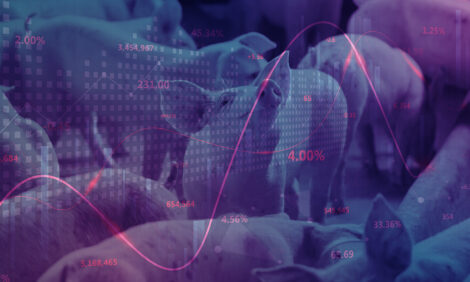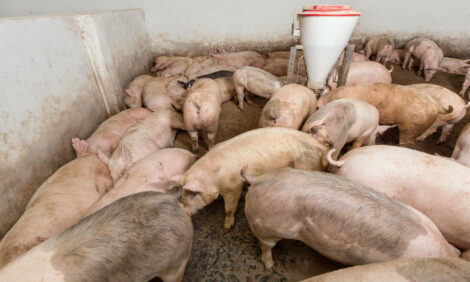



UK/EU Pig Statistics - June 2004
This article provides an overview of the latest statistics relating to pigs in the UK and Europe and includes Slaughter figures, Carcase weights, Pigmeat production, trade and supplies and UK and EU Prices and value of pigs. Extracted from the quarterly pig bulletin published by Defra.1. Pig slaughterings
The graph below illustrates the trends in the monthly results and the average weekly
slaughter:

9.1 million clean pigs were slaughtered in the UK in 2003, a fall of 11 per cent on 2002.
Factors contributing to this fall include the continuing decline in the breeding herd and reduced
productivity of sows (i.e. the number of pigs reared per sow).
The reduction in productivity of sows is thought to be due to the impact of specific pig diseases such as Postweaning Multisystemic Wasting Syndrome (PMWS) and Porcine Dermatitis Nephropathy Syndrome (PDNS), and also possibly to a higher proportion of older sows in the herd following the disruptions to the market in 2001 as a result of Foot and Mouth disease related movement restrictions and export bans.
The very hot summer weather is thought to have had a negative impact on both growth rates and mortality, and this may also have kept slaughter levels down in the autumn. The total number of clean pigs slaughtered in January to May 2004 decreased by 5 per cent when compared with 2003.
In 2003 sow and boar slaughterings (at 240 th. head) decreased by 24% in comparison with 2002. In 2001 the export ban imposed as a result of FMD removed one of the major markets for cull sow meat and many producers kept their sows for an extra litter. From November 2001, when exports could be resumed, sow and boar slaughterings started to increase. In the first five months of 2004 sow and boar slaughterings have decreased by 9 per cent when compared with 2003.

Disease Outbreaks.
The number of slaughterings for pigmeat production at UK abattoirs during August to December 2000 was significantly affected by the outbreak of swine fever in parts of England.
258,000 pigs were slaughtered as a result of the disease and associated welfare disposal schemes. Slaughterings were then further affected by the Foot and Mouth disease outbreak over the period February to September 2001. 149,000 pigs were slaughtered following confirmation of disease or as dangerous contacts.
A further 287,000 pigs were slaughtered under the Welfare Disposal Scheme. None of these pigs are counted in the slaughterings in Tables 1 and 2 above, nor used for meat production.
EU pig slaughterings
Numbers of EU pig slaughterings are only available in total, as the statistical legislation does
not require Member States to differentiate between clean and cull slaughterings.
In 2001, EU slaughterings fell by 1%, with increased slaughterings in Germany, Spain, Denmark, Italy and Belgium being more than offset by reduced slaughterings in France, Netherlands and the UK, largely because of Foot and Mouth Disease. In 2002, all the main pig producing member states (except Netherlands, Belgium and the United Kingdom) have shown increases in slaughterings. In 2003 most producing member states (except France,the Netherlands and the UK) showed increases in slaughterings.

2. Carcase weights
Carcase weights of both clean pigs and sows and boars were higher in almost every month of
2001 compared with the same months in the previous two years. In 2001 there were delays in
livestock being sent to slaughter due to the movement restrictions and exports bans imposed
as a result of the FMD outbreak, which could have lead to an increase in slaughter weight.
However average carcase weights in 2002 also, on average, remained higher than in 2000,
suggesting a more permanent shift in processors specifications towards higher carcase
weights. In comparison with 2002 the average clean pig carcase weight in 2003 was 2%
higher, and the sows and boars average carcase weight was 3% higher. There was a decline
in carcase weights between January and April 2004, followed by some recovery in may.
Despite this decline, carcase weights in the first five months of 2004 remained higher than in
the corresponding period of 2003.

UK sow and boar carcase weights

3. Pigmeat production, trade and supplies
Pigmeat production is calculated from information on slaughterings and average carcase
weights. A separate quarterly survey of bacon and ham production provides data on the
amount of pigmeat that is cured. The quantity of pork produced is calculated as the difference
between total pigmeat production and the quantity cured.
There are several measures of production used within this section. They are defined as
follows:
- Home killed production: Meat produced from all pigs slaughtered in the UK.
Home fed production: Meat produced from all pigs fattened in the UK. This measure includes the carcase meat equivalent of live (non-breeding) pig exports but excludes the carcase meat equivalent of pigs imported for immediate slaughter.
Home cured production: This relates only to bacon and ham production and is a measure of the quantity of bacon and ham cured in the UK wherever the origin of the pigmeat.
Around 80% of the total pigmeat produced in the UK is used for pork and 20% for bacon and ham. In 2002 UK home killed production of pigmeat increased by 2% compared with 2001, but fell by 14% when compared with 2000.
The increase in total pig meat production was entirely due to higher sow meat production, as production from clean pigs continued to fall. In 2003 UK home killed production showed a decline of 10% compared with 2002. Over the first five months of 2004 total pigmeat production fell by 4 per cent when compared with the same period in 2003.
In 2002, 70% of home cured production was sourced from home-killed pigs, compared with 74% in 2001 and 78% in 2000. In 2003 this proportion declined to 55% and has continued to fall in the first five months of 2004.

All pigmeat trade data (except imports of bone in pork from Denmark) are sourced from UK Intrastat data (EC) and Customs and Excise returns (Non-EC). The UK Intrastat data is thought to under record the level of bone in pork imported from Denmark so Danish Intrastat data on exports to the UK for the same commodity codes have been used instead. The import and export data exclude meat offals and preserved or manufactured products.

During 2002, pork imports were 18% higher than a year earlier. Exports for 2002 were 149% higher than the previous year, when there had been restrictions due to Foot and Mouth Disease.
The shortage of home-produced supplies meant that imports reached record levels in 2003 (up 33 per cent) and exports were 23% lower when compared with 2002. The continuing downturn in home-produced supplies in early 2004, meant that import requirements continued to increase. Imports were 10% higher and exports 13% lower during the first quarter of 2004 compared to the same period of 2003.
In 2003 imports increased by 3% when compared with 2002. In the first quarter of 2004 imports have remained steady.
In 2003 total domestic usage of pork was 9% higher than in 2002 with higher imports (+33%) and fewer exports (- 22%) offsetting the 8% fall in production. However some of the recorded increase in pork imports went into curing as bacon. The first quarter of 2004 has seen a 5% increase in domestic usage compared with the same period in 2003 due to increased imports (+9%) which more than offset the 1% decrease in production and 12% decrease in exports.
In 2004 domestic usage of bacon and ham was 2% lower when compared to 2003 and home cured production decreasing by 6%.
4. Pig Prices and Value of Pigs and Pigmeat Production
The reference prices shown here run to the week ending 13 June 2004. In the latest week the
UK reference price was €15.37 per 100kg above the EU average.
The following graph compares the average finished pig price (adjusted eurospec average –
UK) with average compound pig feed prices (GB). (Compound feed prices are published
retrospectively, three months after the end of the period concerned, to protect the commercial
confidentiality of respondents. The latest published figures are for February 2004). The
average finished pig price increased very slightly in the year to February 2004 compared to a
13 per cent increase in the compound feed price over the same period.

Price comparison

5. UK/EU Pig Populations
For information on UK and EU Pig Populations which forms Chapter 5 of this report Click HereLink to main report
To read the full report, including tables (PDF - 23 pages, 318Kb) Click hereSource: Defra - June 2004









